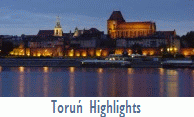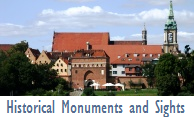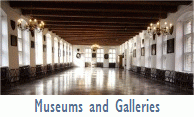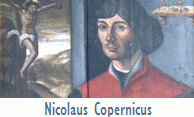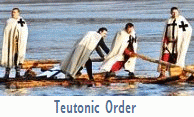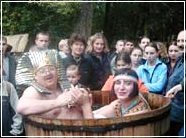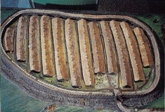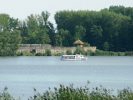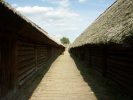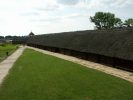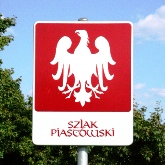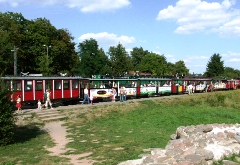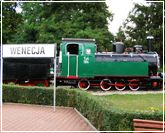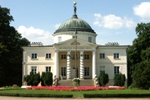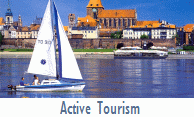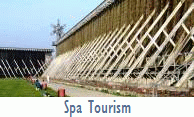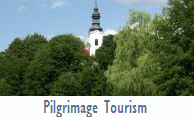|
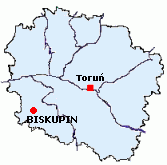 Biskupin Intro Biskupin Intro
- locality in Żnin County (powiat Żnin), Pałuki region
- 92 km south-west of Toruń (National road No. 15 Toruń-Inowrocław-Poznań, from Inowrocław Regional road No. 251 to Żnin)
- the most famous Polish archaeological reservation with fortified settlement of Lusatian culture reconstructed. Inscribed on the Polish National Historical Monuments List.
Biskupin is the best known archaeological reserve in Central Europe. The discovery in 1933 of a 2700-year-old fortified settlement on the peninsula of Lake Biskupinskie was one of the most important events in 20th century Polish archaeology. Excavations were carried out here until the outbreak of World War II. The scale of these excavations and the new scientific methods were famous the world over. After the war work was resumed in 1946 and continued until 1974 when it was decides to leave the reamining wooden structures under water and to concentrate on preserving the prehistoric wood which had already been exposed and was in dire need of conservation.
|
In the years preceeding the celebrations of the Millennium (one thousand years of the Polish statehood), in the 1950s and 1960s Biskupin became an educational centre for young archaeologists. Students of universities departments from all over Poland became to the Archaeological Training Camps not only to take part in excavations but also to recreate ancient technologies used in the crafts and farming. The experimantal archaeology is still an important concern at Biskupin today.
|
|
|
| |
|
| |
|
| |
|
| |
|
|
Archaeological Museum
|
|
Biskupin
Archaeological Festival
|
|
Address:
Biskupin, Biskupin 17 (92 km south-west of Toruń)
Opening hours:
8am - 6pm (wintertime: until dusk)
Admission fees:
8 PLN, reduced: 6 PLN
Booking guides, entrance tickets, further details:
Toruński Serwis Turystyczny,
Guided tour lasts up to 2 hours.
Permanent exhibitions: see here.
See also: Narrow-Gauge Railway Museum here.
|
|
Every year, usually during third week of September one of the greatest archaeological, popular-scientific festivals in Europe takes place in Biskupin. During 9 days within the 24 hectares area of Biskupin reservation different crafts, handiworks and various aspects of spiritual life from prehistory to the Middle Ages are presented to public. Concerts, dances, knights tournaments, slavonic-viking ship replica sailing, minting coins, bow and oxbow shooting, underwater archaeology, baking bread as well as smelting iron in furnaces - it is not even complete list of the festival's attractions.
Experiments go on in three reconstructed pottery kilns, according to unearthed remains from the 1st Millennium BC. Experiments with wood tar and pitch distilling processes have a long tradition in Biskupin experimental archaeology quarter, as well as horn and bone elaborating, weaving, dyeing textiles and other techniques of sometimes almost forgotten crafts.
Except for Biskupin main Archaeological Festival also in May and June the presentations of selected prehistoric and early medieval craft techniques
attract crowds of visitors not only from the region. It is worth to mention that a significant part of Biskupin popular-scientific activity is turned on to schoolchildren and youth. |
|
Building of the Lusatian culture fortified settlement began in the middle of the 8th century BC. The 2 ha swampy peninsula was first surrounded by a breakwater of slanting piles driven into the ground, then it was encloused by a rampart made of timber compartments filled up with earth and covered with clay. The settlement comprised thirteen rows of wooden houses, each row covered by a common thatched roof of reeds. There were about 100 dwellings altogether - one for each family.
|
Biskupin Lusatian culture settlement model.
Click to enlarge
|
All the homes had similar area (about 80 sq m), divided into two parts: a vestibule and a main chamber. The big room had a fireplace in the centre and a large bed on the left where a whole family of eight to ten persons could sleep. The whole settlement is thought to have had about 800 - 1000 inhabitants. The only acces into the village was over 250 metre long bridge running from the southern shore of the lake to a single gateway ion the rampart, probably surmounted by a guard tower.
.JPG) The inhabitants of Biskupin were farmers, animal breeders and hunters. They skilfully utilized natural resources and had wide traiding contacts. But to live in relative safety they had to build fortifications. Their settlenet is a wonderful example of the extremely functional architecture prevalent in this part of Europe towards the end of the Bronze Age and in the early years of the Iron Age. The inhabitants of Biskupin were farmers, animal breeders and hunters. They skilfully utilized natural resources and had wide traiding contacts. But to live in relative safety they had to build fortifications. Their settlenet is a wonderful example of the extremely functional architecture prevalent in this part of Europe towards the end of the Bronze Age and in the early years of the Iron Age. The Biskupin settlement was abandoned after about 150 years because a cooling in the climate and rising water levels made the increasing waterlogged peninsula uninhabitable. Luckily for achaeologists the silt from the lake and a layer of peant covered and protected large fragments of the breakwater, rampart, streets and houses.
|
Piasts' Route (Szlak Piastowski)
|
|
|
It's one of the greatest attraction of Poland, runs through many interesting localities over Greater Poland (Wielkopolska), Pałuki and Kuiavia (Kujawy) regions, including Biskupin. Its route goes via sites associated with the beginnings of Polish statehood.
• More on the Route here.
|
|
Attractive way to getting to Biskupin is the travel by narrow-gauge train. The journey starts in neighbouring town of Żnin, goes via Venice (Wenecja), Biskupin to Gąsawa. It takes some 45 minuntes and in the tourist season runs 6 times a day.
• Time-table and ticket prices here.
• Narrow-Gauge Museum at Wenecja here.
|
........................................................................................................................................................................... The picturesque land called Pałuki where Biskupin is located, is a rolling countryside with lakes, meadows and forest complexes, rich with prehistoric and medieval monuments.
The most important tourist attractions there are:
Biskupin Surroundings: Żnin
 14 km north of Biskupin (78 km south-west of Toruń). Town rights: 1263. 14 km north of Biskupin (78 km south-west of Toruń). Town rights: 1263. The town excellently located between two lakes: Żninskie Duże (Lake Żnin Bigger) and Żninskie Małe (Lake Żnin Smaller), the town of some 14,000 inhabitants is considered to be the capital of Pałuki region. The symbol of Żnin is the Gothic town hall tower erected in the 15th century standing in the centre of the Market Square. This former seat of the municipal authorities houses the Museum of Pałuki now. In Żnin one can find the Museum of Sacred Art in a historical suffraganry. Right opposite the late-Gothic church of St. Florian is located.
Jan and Jędrzej Śniadecki, outstanding scholars of the Enlightment were sons of the mayor of Żnin, Poeat Klemens Janicki, a peasant's son and the precursor of the Polish Enlighment was born in the village of Januszkowo near Żnin. Erasmus Glicner, a famous Renaissance religious writer, senior of Protestants and preacher at St. George's church in Toruń was born in Żnin as well.  Znin. Gothic town hall tower |  Znin. Gothic St. Florian church |  Znin. Monument to Jan Sniadecki |
Biskupin Surroundings: Wenecja
(Polish for: Venice)
|
|
Narrow-Gauge Railway Museum
|
 Village located amidts three lakes, 5 km away from Biskupin (85 km south-west of Toruń), was established in the late 14th century by Mikołaj Nałęcz, a powerful and welthy knight who landed in legends as "the Blody Devil of Wenecja". He erected a castle in 1420 which became the seat of archbishop Mikołaj Trąba. Since 1471 it was deserted, demilished and pulled down. Today the castle ruins are the local tourist attraction. Village located amidts three lakes, 5 km away from Biskupin (85 km south-west of Toruń), was established in the late 14th century by Mikołaj Nałęcz, a powerful and welthy knight who landed in legends as "the Blody Devil of Wenecja". He erected a castle in 1420 which became the seat of archbishop Mikołaj Trąba. Since 1471 it was deserted, demilished and pulled down. Today the castle ruins are the local tourist attraction.
Another attraction is the Narrow-Gauge Railway Museum with a period waiting room. It is one of few heritage parks in Europe presenting the railway rolling stock on only 600-mm-wide tracks. A 'living' museum exhibit is a little train running in the tourist season on the route Żnin-Wenecja-Biskupin-Gąsawa. More on it here.
Picturesque location among three lakes resulted in its name alluding to the location of Italian Venice (Polish: Wenecja). |
|
• More details here
An open-air museum in Wenecja collects and exhibits steam locomotives, passenger and freight cars, trolleys, railwaymen's tools, signalling equipment, contents of an old waiting room, old maps. One of the oldest locomotive is the German one made by Orenstein & Koppel in Berlin in 1900.
|
i Biskupin Surroundings: Gąsawa
 Village located 3 km south of Biskupin (95 km south-west of Toruń). Village located 3 km south of Biskupin (95 km south-west of Toruń). Fair settlement mentioned in 1145 as the property of the monastery of Canons Regular in nearby Trzemeszno. In 1227 a meeting of Piast princes took place here in order to establish heritage of districts specified in the last will of Polish King Bolesław Krzywousty. As a results of the princes' congress the fratricidal fighting erupted. Prince of Krakow and Sandomierz - Leszek Biały (Leszek the White) suffered the death in nearby Marcinkowo. Close to the road stands a monument of him, showing the moment of death of Prince, built in 700th anniversary of the event in 1927, rebuilt after German demolishon during World War II.
The timber church of St. Nicholas in the Gąsawa's market square dated back to the 17th century. 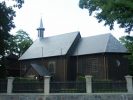 Gasawa. Baroque timber church, 1674 |  Marcinkowo. Monument to Leszek the White | | |
Biskupin Surroundings: Lubostroń
|
|
Lubostroń Palace Museum
|
 Village located 22 km north-east of Biskupin (71 km south-west of Toruń). Village located 22 km north-east of Biskupin (71 km south-west of Toruń).
The local palace is one of the most beautiful classicistic palaces in Poland. Its central part is covered with a copula finialed with a statue of Atlas. It was built in 1800 in accordance to a design by Stanisław Zawadzki.
The interior wall painting were done by brothers Franciszek and Antoni Smuglewicz. The palace was the property of counts Skórzewski. Stefan Garczyński, a poet related to them was brought up here and he used to stay here frequantly. A plaque devoted to him was unveilded on the building of the palace annexe in 1997.
A hotel and restaurance were established in the beautifully restored buildings near the palace (annexe and coach house). |
|
Inside the decorations from the period 1800-1806. In the rotunda hall - the central palace's room - walls and pilasters with four large red stucco reliefs. Living room floor is inlaid with Polish and Lithuanian coats of arms in the middle. The living room was decorated in the time of Polish partitions and bear witness to the patriotism of the owners.
|
Biskupin Surroundings: Mogilno
 The seat of County Mogilno is located 27 km south-east of Biskupin (75 km south-west of Toruń) on the border between Pałuki and Kuiavia historical regions. 12,500 inhabitants. The seat of County Mogilno is located 27 km south-east of Biskupin (75 km south-west of Toruń) on the border between Pałuki and Kuiavia historical regions. 12,500 inhabitants.
On the peninsula towering over the lake and surroundings there is an impressive structure of Romanesque Benedictine monastery. According to tradition, in 1065 King Bolesław Śmiały (Bolesław the Brave) brought here Benedictine Friars from Tyniec near Krakow, establishing one of the first monasteries in Poland. Later hypothesies moved this fact back to the mid. 11th century, where King Kazimierz Odnowiciel (Casimir the Restorer) was the supposed founder. The monastery was of significant church and state importance. lt participated in Christianisation of Kuiavia (Kujawy) and Mazovia (Mazowsze) regions, and later Chelmno Land and whole of Pomerania (Pomorze) region. The first early-Romanesque seat of Benedictine Friars was one of the most magnificent stone structures of Poland. The settlement attached to the monastery gained civic rights from King Władysław Jagiełło (Ladislas Jagiellon) in 1398. When Mogilno became a part of the German Prussian section of partitioned Poland in 1772 it constituted the beginning ofthe end of Mogilno friars. In 1833 the abbey was closed down. Then the monasterial buildings housed schools, hospitals and a shelter for women; during the German occupation (1939-1945) there was a camp, and after the war a culture centre. ln the years 1970-1980, art historians from the Nicolaus Copernicus University of Toruń conducted wide historical-architectonic research of the whole monasterial complex in Mogilno.
During archeological excavations, led under the management of Prof. Jadwiga Chudziakowa, the oldest Romanesque artefacts were partially restored and exhibited. The research has been continued. What's more important: within the scope of the all-Poland program of rescuing Polish Romanesque monuments "Polonia Romanica", remodelling works are under way in the monastery of Mogilno; it is being prepared to a new this tirne a tourist role, since a hostel is to be opened here.Mogilno another monument is the late-Gothic church of St. James from the late 16th century. It was built on the spot of earlier temple (parish of Mogilno founded at the turn of the 11th and 12th century by the knight Zbylut of Pałuk dynasty), was rebuilt and renovated several times. 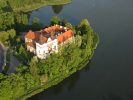 Mogilno. Monastery's bird's eye view | 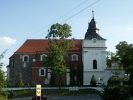 Mogilno. Benedictine Monastery | 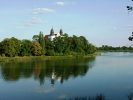 Mogilno. Benedictine Monastery on the lake |
|
Curent local weather in Toruń  | temp. 7.3° C |
|
b.bmp)
b(1).bmp)
.JPG) The inhabitants of Biskupin were farmers, animal breeders and hunters. They skilfully utilized natural resources and had wide traiding contacts. But to live in relative safety they had to build fortifications. Their settlenet is a wonderful example of the extremely functional architecture prevalent in this part of Europe towards the end of the Bronze Age and in the early years of the Iron Age.
The inhabitants of Biskupin were farmers, animal breeders and hunters. They skilfully utilized natural resources and had wide traiding contacts. But to live in relative safety they had to build fortifications. Their settlenet is a wonderful example of the extremely functional architecture prevalent in this part of Europe towards the end of the Bronze Age and in the early years of the Iron Age. 



